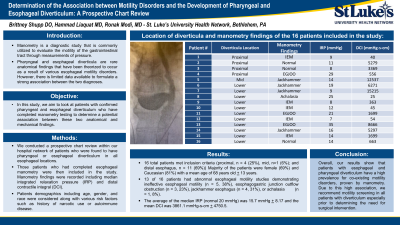Back


Poster Session C - Monday Afternoon
Category: Esophagus
C0218 - Determination of the Association Between Motility Disorders and the Development of Pharyngeal and Esophageal Diverticulum: A Prospective Chart Review
Monday, October 24, 2022
3:00 PM – 5:00 PM ET
Location: Crown Ballroom

Has Audio

Brittney Shupp, DO
St. Luke's University Health Network
Bethlehem, PA
Presenting Author(s)
Ronak Modi, MD, Brittney Shupp, DO, Hammad Liaquat, MD
St. Luke's University Health Network, Bethlehem, PA
Introduction: Manometry is a diagnostic study that is commonly utilized to evaluate the motility of the gastrointestinal tract through measurements of pressure in patients who complain of dysphagia, reflux, or chest pain. Pharyngeal and esophageal diverticula are rare anatomical findings that have been theorized to occur as a result of various esophageal motility disorders; however, there is limited data available to formulate a strong association between the two diagnoses. In this study, we aim to look at patients with confirmed pharyngeal or esophageal diverticulum who have completed manometry testing to determine a potential association between these two anatomical and mechanical findings.
Methods: Methods: We conducted a prospective chart review of patients within our hospital network who were found to have diagnosed pharyngeal or esophageal diverticulum in all esophageal locations including the proximal, mid, and distal esophagus. Those patients who had completed esophageal manometry were then included in the study. Manometry findings were recorded including median integrated relaxation pressure (IRP) and distal contractile integral (DCI). Additionally, patient demographics including age, gender, and race were considered along with various risk factors such as history of narcotic use or autoimmune disease.
Results: Results: 16 total patients met inclusion criteria (proximal esophagus, n = 4 (25%), mid esophagus, n=1 (6%); and distal esophagus, n = 11 (69%). Majority of the patients were female (69%) and Caucasian (81%) with a mean age of 68 years old + 13 years. No patients were on narcotics during the manometry study or had a diagnosed autoimmune disorder. A large majority (n = 11 (69%) of diverticula were identified in the distal esophagus. 13 out of the 16 patients had abnormal esophageal motility studies demonstrating ineffective esophageal motility (n = 5, 38%), esophagogastric junction outflow obstruction (n = 3, 23%) jackhammer esophagus (n = 4, 31%), or achalasia (n = 1, 8%). The average of the median IRP (normal 20 mmHg) was 15.7 mmHg + 8.17 and the mean DCI was 3861.1 mmHg-s-cm + 4750.5.
Discussion: Overall, our results show that patients found to have esophageal diverticulum have a very high prevalence of co-existing motility disorders, proven by manometry. Therefore, due to this high association, we recommend motility screening in all patients with diverticulum especially prior to determining the need for surgical intervention.
Disclosures:
Ronak Modi, MD, Brittney Shupp, DO, Hammad Liaquat, MD. C0218 - Determination of the Association Between Motility Disorders and the Development of Pharyngeal and Esophageal Diverticulum: A Prospective Chart Review, ACG 2022 Annual Scientific Meeting Abstracts. Charlotte, NC: American College of Gastroenterology.
St. Luke's University Health Network, Bethlehem, PA
Introduction: Manometry is a diagnostic study that is commonly utilized to evaluate the motility of the gastrointestinal tract through measurements of pressure in patients who complain of dysphagia, reflux, or chest pain. Pharyngeal and esophageal diverticula are rare anatomical findings that have been theorized to occur as a result of various esophageal motility disorders; however, there is limited data available to formulate a strong association between the two diagnoses. In this study, we aim to look at patients with confirmed pharyngeal or esophageal diverticulum who have completed manometry testing to determine a potential association between these two anatomical and mechanical findings.
Methods: Methods: We conducted a prospective chart review of patients within our hospital network who were found to have diagnosed pharyngeal or esophageal diverticulum in all esophageal locations including the proximal, mid, and distal esophagus. Those patients who had completed esophageal manometry were then included in the study. Manometry findings were recorded including median integrated relaxation pressure (IRP) and distal contractile integral (DCI). Additionally, patient demographics including age, gender, and race were considered along with various risk factors such as history of narcotic use or autoimmune disease.
Results: Results: 16 total patients met inclusion criteria (proximal esophagus, n = 4 (25%), mid esophagus, n=1 (6%); and distal esophagus, n = 11 (69%). Majority of the patients were female (69%) and Caucasian (81%) with a mean age of 68 years old + 13 years. No patients were on narcotics during the manometry study or had a diagnosed autoimmune disorder. A large majority (n = 11 (69%) of diverticula were identified in the distal esophagus. 13 out of the 16 patients had abnormal esophageal motility studies demonstrating ineffective esophageal motility (n = 5, 38%), esophagogastric junction outflow obstruction (n = 3, 23%) jackhammer esophagus (n = 4, 31%), or achalasia (n = 1, 8%). The average of the median IRP (normal 20 mmHg) was 15.7 mmHg + 8.17 and the mean DCI was 3861.1 mmHg-s-cm + 4750.5.
Discussion: Overall, our results show that patients found to have esophageal diverticulum have a very high prevalence of co-existing motility disorders, proven by manometry. Therefore, due to this high association, we recommend motility screening in all patients with diverticulum especially prior to determining the need for surgical intervention.
Disclosures:
Ronak Modi indicated no relevant financial relationships.
Brittney Shupp indicated no relevant financial relationships.
Hammad Liaquat indicated no relevant financial relationships.
Ronak Modi, MD, Brittney Shupp, DO, Hammad Liaquat, MD. C0218 - Determination of the Association Between Motility Disorders and the Development of Pharyngeal and Esophageal Diverticulum: A Prospective Chart Review, ACG 2022 Annual Scientific Meeting Abstracts. Charlotte, NC: American College of Gastroenterology.
